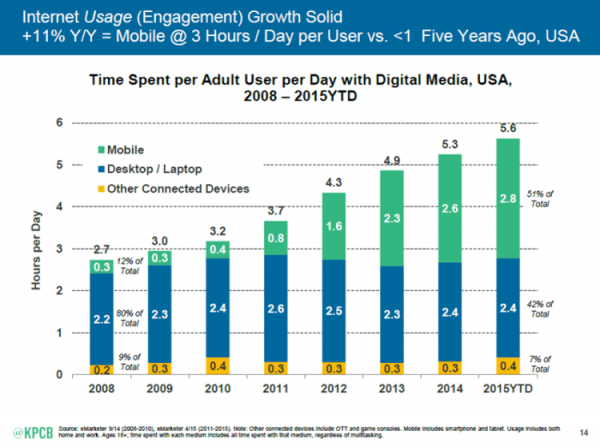Despite some debate over how vertical videos don’t make the best use of TVs and monitors,it has still seen an increase in use. Snapchat is even pitching it as a viable format for advertising. There are plenty of reasons why vertical video usage is on the rise, and how it can become a worthwhile resource to marketers moving forward.
First up, a report from AdWeek suggests that, based on findings from the Digital Content NewFronts, vertical video is becoming a higher accepted medium on Snapchat. The site reports that the best-performing shows and ads are ones that are originally shot in a vertical format, are viewed nine times more frequently than horizontal ones, and are more often viewed to completion.
Medium has similar findings, stating that one of the reasons for this is that consumers hold their phones vertically 90 percent of the time anyway, not just due to Snapchat, but also other socially viable applications like Meerkat and Periscope. “This behavior is becoming even more normalized as more and more content is being shot natively in portrait mode,” says the article. “So rather than having to constantly switch between how we naturally hold our phones (vertically) to the way most media has traditionally been formatted (horizontally), users are now able to enjoy content the way they’ve secretly always wanted to — upright, up close and personal.”
Jon Steinberg, CEO at Daily Mail, stated, “The whole notion of turning your phone on its side to watch a video is awkward and a bit of a hassle.”
The report also estimates that over 700 million vertical photos and videos are shared on Snapchat a day —data that is backed by Business Insider.
Clickz had its own say on the matter. Rob Norman, chief digital officer for GroupM, said: “In order to be successful, all media and all advertising has to have the most comfortable and organic experience. There is an inherent logic that in a portrait-style device, the content would be oriented in a portrait-style way. This comes to the very heart of the real meaning of native, so advertising has always worked best when it’s formatted and native to the device or medium in which it’s presented.”
AT&T is aware of the success of the format, adding the original program SnapperHero to the Snapchat lineup, and using a vertical format all the way through. “Visual elements that artfully play into the functionality of the platform will always perform best, which is why vertical video was an obvious choice for this project,” said Liz Nixon, director of emerging and social media marketing for AT&T Mobility. “Once we set off in that direction, we planned our shots, edges and storylines to depend on every pixel available to us on Snapchat in a way we wouldn’t have for a square or traditionally horizontal film.”
It’s a risk that paid off, with a 73 percent average completion rate for the episodes posted in the program. “When SnapperHero launched, Snapchat still required viewers to press the screen to keep videos playing, so we were impressed not only by the completion rate but also by the fact that so many viewers were willing to remain engaged throughout the episode to keep the story open,” said Nolan. “However, it’s difficult to say whether engagement can be directly attributed to the videos being vertical, but it certainly didn’t seem to have a negative impact.”
Speaking about the format, Norman added, “It’s not exactly the riddle of the sphinx, but what vertical video tells us in a macro sense is that, increasingly, there will be demand for assets that are native to the platforms they run on and the vendors who run on those platforms. This is how a physical format change that just amplifies the need for platform and vendor specific creative.”
DigiDay also commented on the matter, explaining that the time to take vertical video seriously has officially come. “That’s because vertical video delivers better results than standard video in environments where people tend to hold their devices upright,” the article reads. It also noted that having to turn your device to view a particular video comes across as “totally stupid,” when it should be more organic based on how someone holds their phone.
A number of advertisers, aside from AT&T, have managed to create effective vertical video assets for Snapchat, including Burger King with its wildly successful Chicken Fries, as well as brands like Macy’s and Spike.
Steinberg did admit that not everything works in the format, but it’s still successful. “I don’t know if I’d want to watch Avatar vertically. But I’m obsessed with Periscope, and I’ve watched Periscopes for 20 or 30 minutes and not had any problem.”
“It is easier and more comfortable to move the eyes horizontally than vertically, especially up,” said Dr. Eli Peli, a professor of ophthalmology for Harvard Medical School. “However, neither of these facts will have an impact on comfort or safety of using a vertical presentation on a smartphone. The visual field extent of a smartphone held at arm length is very small. The vertical extent of the field is much wider than this, as is the ability to move the eyes and scan vertically.”
Steinberg also added, “We need to be doing vertical video from an editorial standpoint as well. We’re just as responsible.”
ReelSEO has some vertical video statistics, with Meeker breaking down the types of content that people watch. As you can see from the chart below, people are spending several hours a day watching video on their mobile devices, even more than they were back in 2008. That means more opportunities to view vertical video.

Vertical video advantages, summed up:
- More comfortable viewing, since it can be easier to scan in vertical than horizontal
- More supporting apps, like Snapchat and Periscope, are making more use of vertical video
- More original programming being considered for the format
It’s probably going too far to say that vertical video will soon replace the standard horizontal format, since YouTube doesn’t have vertical viewing support yet, but it’s bound to keep growing in popularity as more people use mobile devices to watch video content.

